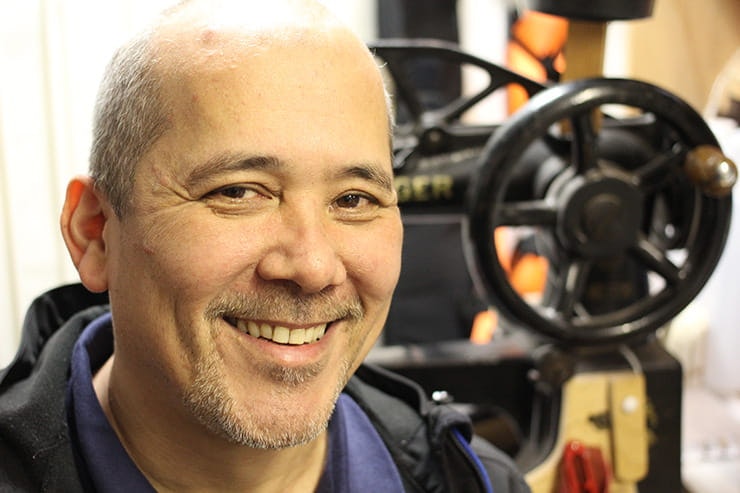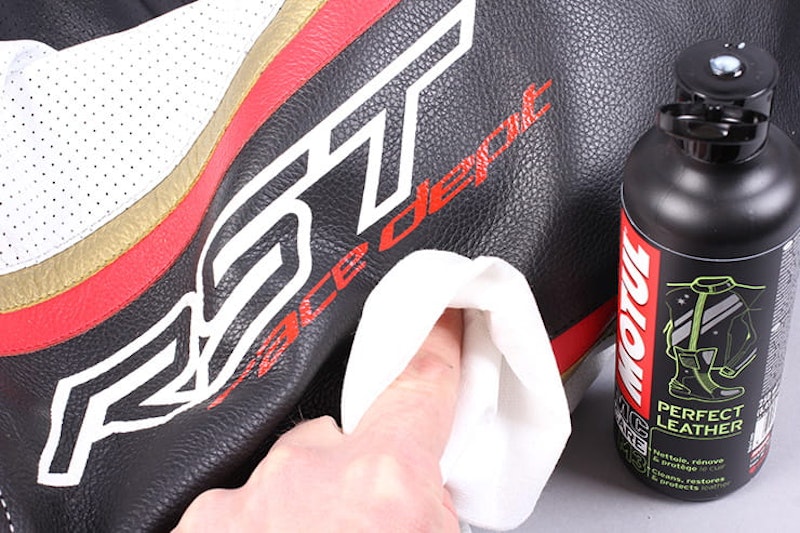How to care for motorcycle leather kit
By John Milbank
Consumer Editor of Bennetts BikeSocial
18.12.2017
If you ride in an open-face helmet you’ll know how much it can sting when a bug hits you. Your bike kit is constantly being bombarded with dirt, water and road salt… as well all those insects that weld themselves into the grain pattern of your leathers. As the clothing moves, the bugs and grime abrade the surface, which breaks down the thin protective polyurethane layer that’s over almost all motorcycle leather kit. Lose that layer and the hide becomes more absorbent, and more susceptible to weakening.
Alan Lui of www.lincsrepair.co.uk is the man trusted by Kushitani UK to repair the company’s crash-damaged suits: “Every time you touch your kit,” he says, “you leave the oils from your skin on it – if the leather’s thin protective layer has been in any way damaged, it sucks that oil in.
“We’re naturally quite alkaline, but leather has a fairly neutral PH level, so that alkaline gets sucked deep into the fibres of hide and damages it. When you see the dark marks on a leather car headrest for instance, the small patch is just the tip of the iceberg – the oils and damage have built up from the bottom until they become visible at the top. That’s a lot of gunk…
“The tanning process makes leather imputrescible – it won’t rot – but the grease and ‘cheese’ from your body sokes into and between the fibres of your leathers and separates them, before rotting itself. This gunk stops the leather absorbing the natural moisture that it gets from the air, which keeps them hydrated and helps them stay soft ad supple. Without a certain level of moisture, leather will go hard and crack.”
Read our article about the different types of hides and how to choose the best kit and you’ll know that motorcycle leather is chrome tanned, with a thin protective layer over the surface that stops the highly absorbent, fibrous leather from soaking up wate and other contaminants. We’re looking here at how to care for leather motorcycle jackets, trousers, gloves and one- and two-piece suits specifically – veg tanned saddle bags, sofas, car interiors and handbags all require different care, and you should also use a specific product for leather motorcycle boots.
Use a cleaning product designed specifically for bike leathers
So how should I keep my leather kit clean?
Because leather is PH neutral, look for a PH neutral motorcycle leather-specific cleaner. You could use a very simple soap, but it really is worth buying a product designed for the job. Items designed for leather car interiors aren’t always suitable for bike leathers, and equally don’t use saddle soap – while it’s been fine for years on equestrian kit, that’s veg tanned, and very different to chrome tanned motorcycle leather. Veg tanned hides tend to be far more robust, and saddle soap has lye in it, which is corrosive. Plus saddles are re-oiled after cleaning...
You should not oil your bike leathers – by its very design, you’re not meant to be able to get anything past that pigmented coating, so all a product like this will do is sit on the top. It will eventually soak through, but you shouldn’t be trying to soften bike kit – you just need to keep it clean and protected from moisture.
Neetsfoot oil is another thing not to use on bike leathers, simply because it’s a softener, and it’s not designed for this type of leather. Anything with waxes in just sits on top of a pigmented leather. Then dirt and grit gets trapped in it, which abrades the protective surface of the leather.
So, using a bike specific product, gently wipe it with a cloth, or use a soft-bristled brush or sponge in a circular motion. Don’t scrub at it – just go easy to gently lift the bugs and grime off; you’re simply agitating the dirt. Then, with a sponge slightly damp in warm water, just rinse them off. Finally, you should use a proactive product designed for bike leathers – be guided by the instructions on the pack.
Never use a microfibre cloth – the little fibres that grab the dirt will hold it and abrade the surface coating, causing more damage. Your best bet is cheap face cloths – terry towels or similar. Some people use baby wipes and other skin care products, but this isn’t a great idea as skin has natural oils in it, and it also regenerates. Leather doesn’t! Using some of these products is like T-Cutting the leather, which opens up the surface and accelerates the degradation process.
Leather shouldn’t be soaked, so if your gear has got really filthy, inside and out, you should send them to a professional.
The black leather shown here is chrome tanned, while this beige is veg tanned – look at the difference in the fibre structures
What if I get caught in a rain storm?
Leather goes hard when the fibres have dried and altered; if you leave it to dry naturally it’ll loosen up again. If you force dry it too quickly – for instance by putting your kit on the radiator – it draws out the natural moisture that’s so important, making it brittle. Just leave your gear where there’s warm air that can circulate while it hangs. Force drying can weaken the bond between the fibres, but if you let leather dry naturally it’ll tend to spring back to its original form.
Force drying too often will eventually damage the leather’s structure, but the only time you might find out is if you come off in them.
My mate put his leathers in the washing machine and they looked great when they were dry
Soaking leather makes it swell up, which will definitely start to weaken it. Household detergents are also very bad for the leather as they can strip out the much-needed chemistry, leaving the fibres dry, prone to unbonding and extremely weak… if your kit is so dirty that you think this is a good idea, spend £50 to £60 on having it professionally cleaned, but the dirt is most likely just on the surface, and can usually be cleaned with the appropriate product.
A lot of people use Febreeze or similar to freshen up the inside of their leathers, but this is only really masking the smell, not removing the detritus inside. The best way to do this is to have the leathers sorted professionally, and treated in an ozone chamber as this will kill the bacteria that produces the offensive smell.
I’ve got bug remover for my bike – that works a treat on my leathers
No – it’s far too harsh and will damage the surface of the leather. As a rule of thumb, treat your motorcycle leathers as you would your own skin – don’t rub hard with a stiff brush, and don’t use nasty chemicals. Don’t use Vaseline either – it’s petro-chemical based. “People use some weird stuff,” says Alan. “I’ve been out to a job where a lady had used mayonnaise on her sofa. It stank, and it was ruined.
“Leather isn’t skin, but treat it like it is; a non-regenerating skin. Some of the chemicals used in face creams are there to help the softening products to be absorbed into the skin, but your skin exfoliates and regenerates – this stuff just goes onto leather, then builds up in the fibres.
“I’ve seen peanut butter used, Mr Sheene, as well as kitchen cleaners. Would you rub Cillit Bang on your face? I’ve seen people use it on leather.”
Where should I store my leathers?
Leave them hanging, with air free to circulate. Don’t keep them in a cold, damp shed or garage as the moisture will build up and they’ll start to get mouldy.
Thinking of leather as a generic product is like considering all metals as one, regardless of if they’re painted, anodised, steel, aluminium, brass etc… You really shouldn’t use the same products you bought to keep your sofa, saddle, boots or car interior clean and supple – chrome tanned motorcycle kit needs its own specific care, so spend an extra tenner or so and protect your investment…
Thanks to Alan Lui of Lincs Repair www.lincsrepair.co.uk
Share on social media:

